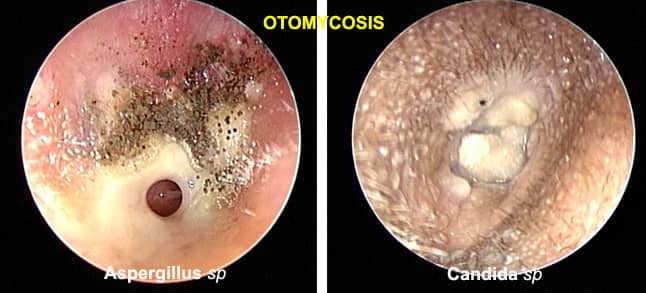Fungal ear infection, also known as Otomycosis is a common problem caused by a fungal infection of the external auditory canal or in simple terms, the formation of fungus in the ear canal. It causes discomfort due to redness and itching. In this article, we will discuss the causes of fungal infection in the ear, fungal ear infection symptoms, and treatment options.
Table of Contents
What Causes Fungal Ear Infections?
We are surrounded by many types of fungi and regularly come in contact with them. Not everyone is prone to fungal infection, it mostly affects people with a weak immune system. Otomycosis is the medical term for fungal ear infection. The fungus mostly thrives in warm tropical climates. The fungus Aspergillus1 is the most common cause of fungal ear infection followed by Candida2.
The following people are at a greater risk of getting Otomycosis.
- Staying in the warm tropical climate
- Suffering from diabetes
- Swimming in contaminated water
- Suffering from Eczema
- Having an open wound in the ear
- Dry ear with no earwax protection
- Low immunity
- Using steroids and antibiotics. Excessive use of antibiotic ear drops alters the Ph level of the ear encouraging fungal growth. (Ph means Potential of hydrogen. It is a measure of how acidic or non-acidic the surface is)
What Are the Fungal Ear Infection Symptoms?
Some of the fungal ear infection symptoms are:
- Redness in the ear
- Itchy ears. Generally, itching is more in fungal infections than in bacterial infections.
- Swelling or inflammation
- Dry flaky skin. In cases where protective earwax is not present
- Clogged ears or feeling of fullness
- Ringing in the ears or tinnitus
- Hearing loss or muffled hearing
- Slight ear pain
- Fungal ear discharge
Fungal Ear Infection Discharge
If Aspergillus is the cause of the ear fungus, you will notice greyish-black or yellow dots surrounded by cotton-like fungus in the ear canal.
If the cause of the ear fungus is Candida, you will not notice any fungal formation but there will be a thick white discharge. Read in detail about ear discharge types and causes.
Ringworm is also a type of fungal ear infection; you will notice a round ringworm on the ear that is red and itchy.
Is Ear Fungus Dangerous?
Ear fungus in the initial stages is just an irritant and causes discomfort. If it is not cured using over the counter anti-fungal cream, you should see a doctor without further delay. Neglect can lead to hearing loss, eardrum perforation, and temporal bone infection. The temporal bone is part of our skull that encloses the middle and the inner ear.
People suffering from low immunity, diabetes, or eczema should take special care and visit a doctor.

What Does a Fungal Ear Infection Look Like?
The doctor will inquire about the history of infections and conduct a physical examination of the ear canal using an otoscope. The otoscope lights up the ear canal and magnifies the view of the infected ear canal.
The doctor may notice thinly spread fungal colonies of different colours or tightly packed fungal growth that fills the whole canal, depending on the severity of the otomycosis.
What Is the Fungal Ear Infection Treatment?
The doctor will first clean the ear and use microscopic suction to remove fungus from the ear. The doctor may recommend stopping all local applications like anti-fungal cream to dry the ears. If the fungal infection is on the earlobe, then anti-fungal cream can be used.
In most cases, anti-fungal ear drops are prescribed for three weeks. Ear drops containing clotrimazole and fluconazole are the most effective3.
If ear drops are found to be ineffective, oral medicines for ear fungal infection containing Itraconazole or Voriconazole are prescribed.
Acetic acid is another common otomycosis treatment. Usually, a two percent solution of these ear drops is used two to three times a day for about a week.
Use only otomycosis ear drops, do not use anti-bacterial ear drops. Using ant-bacterial ear drops will kill the good bacteria in the ear that fights the fungus.
Fungal Infection in Ear Home Remedy
In the early stages of ear fungal infection treatment at home is possible. Diluted hydrogen peroxide or any over the counter ear drops containing carbamide peroxide can clean the ears.
Swimmers are advised to use a mixture of rubbing alcohol and white vinegar to keep their ears dry.
Some natural oils have anti-fungal properties. Use oils only if they have anti-fungal properties. Using any oil to relieve itching is not recommended as it will promote the growth of fungus.
Oil should only be used if the infection is in the outer ear. Do not pour oil drops into the ear, apply oil lightly with your finger on the dry skin.

Can A Fungal Ear Infection Spread?
If the fungal ear infection is due to swimming, then the infection has spread through the contaminated water. Avoid swimming while the ear is infected.
During humid weather, fungus tends to grow on surfaces or clothes which are exposed to dampness. Touching fungus-infected clothes or surfaces transfer the fungus to our hands. At times we insert the same fingers into our ears. This is one of the causes of fungal ear infections.
While most cases of fungal infection spread from external sources. The fungus can also develop in the ear. Dead skin in the ear canal supported by the hot and humid weather can cause otomycosis.
What To Do If Fungal Ear Infection Keeps Coming Back?
A low immune system or being immunocompromised is the main reason for a chronic fungal ear infection or recurring fungal ear infections. Patients undergoing radiation therapy or suffering from diabetes or Aids have a higher chance of suffering from chronic otomycosis.
Fungal ear infections, also known as fungal otitis externa can become recurrent otitis externa in adults if the person regularly uses anti-bacterial ear drops.
The ear drops change the natural Ph of the ear canal allowing the fungus to grow. (Ph means Potential of hydrogen. It is a measure of how acidic or non-acidic the surface is). Chronic ear discharge can also change the Ph of the ear canal. Treat the primary cause to prevent recurring otomycosis.
There have been cases of fungus being transmitted from pets. Do not put your finger in your ears while playing with pets, and wash your hands with antiseptic soap after handling pets.
Swimming in contaminated water or swimming pools without proper chlorination treatment plant is a cause of chronic swimmer’s ear.
What Are the Fungal Ear Infection Complications?
Though fungal ear infection is not a serious issue, it can create complications if treatment is delayed or if the person is immunocompromised (having low immunity).
Delay in otomycosis treatment can lead to hearing loss, tympanic membrane (eardrum) perforation, and temporal bone infection. The fungal infection starts in the outer ear and spreads to the tympanic membrane and further to the temporal bone.
How To Prevent Fungal Ear Infections?
If you are suffering from eczema or are diabetic, then you should take care and follow these simple steps to prevent fungal ear infections.
- Keep your ears dry if you are a regular swimmer. A wet and moist ear is an ideal place for fungal growth in the ear canal.
- Dry your ears well after a shower. Dry your ears gently, aggressive cleaning may result in bruises that will increase the chances of fungal infection.
- Use a mixture of rubbing alcohol and white vinegar to dry the ears.
- Avoid cotton swabs, if you do use them, be gentle and avoid pushing earwax deep inside the ear canal.
- If you use earbuds or in-the-ear headphones to listen to music, use a disinfectant to clean the earpiece regularly or preferably avoid during the ear infection period.
- Do not remove earwax too often, clean if earwax secretion is excessive. A little earwax is good, it keeps the ear canal lubricated and protects from otomycosis.
Follow the above-mentioned tips to prevent fungal ear infections and keep your ears healthy.
Reference:
